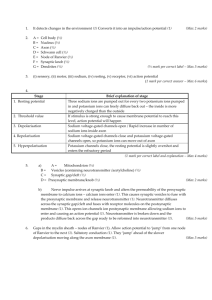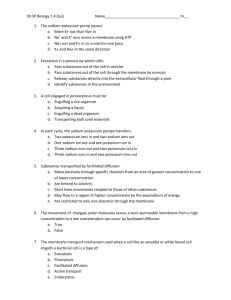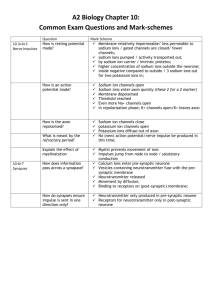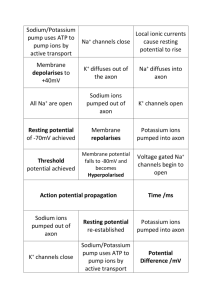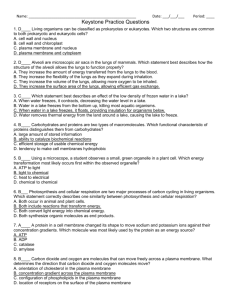Biology 212: January 30, 2002
advertisement
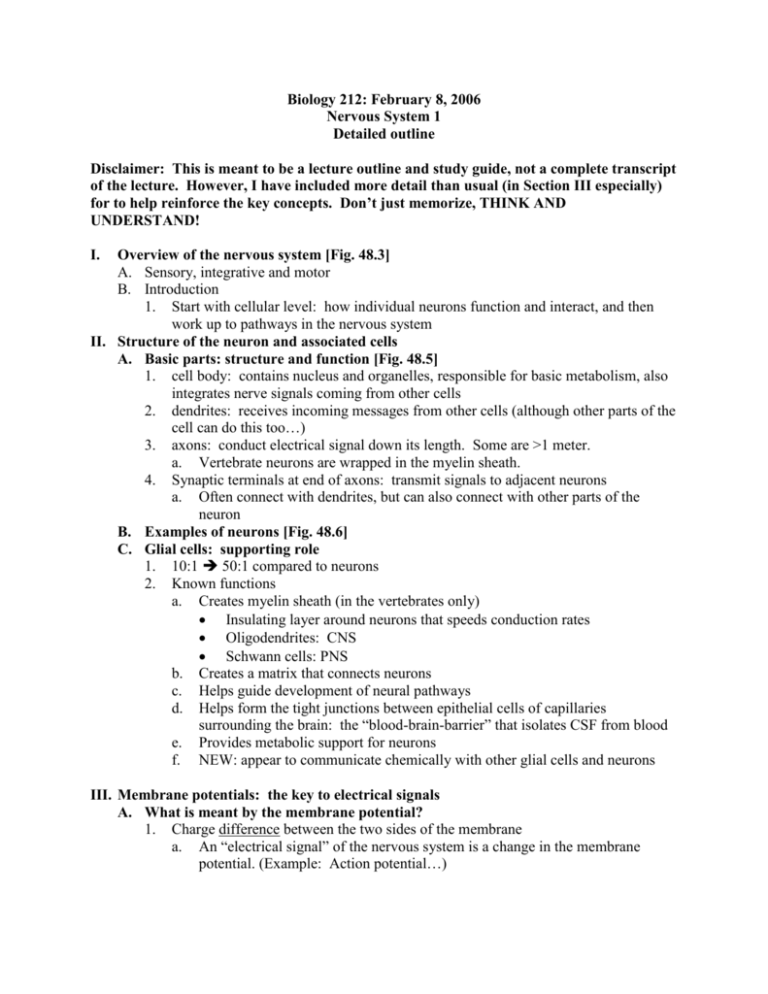
Biology 212: February 8, 2006 Nervous System 1 Detailed outline Disclaimer: This is meant to be a lecture outline and study guide, not a complete transcript of the lecture. However, I have included more detail than usual (in Section III especially) for to help reinforce the key concepts. Don’t just memorize, THINK AND UNDERSTAND! I. Overview of the nervous system [Fig. 48.3] A. Sensory, integrative and motor B. Introduction 1. Start with cellular level: how individual neurons function and interact, and then work up to pathways in the nervous system II. Structure of the neuron and associated cells A. Basic parts: structure and function [Fig. 48.5] 1. cell body: contains nucleus and organelles, responsible for basic metabolism, also integrates nerve signals coming from other cells 2. dendrites: receives incoming messages from other cells (although other parts of the cell can do this too…) 3. axons: conduct electrical signal down its length. Some are >1 meter. a. Vertebrate neurons are wrapped in the myelin sheath. 4. Synaptic terminals at end of axons: transmit signals to adjacent neurons a. Often connect with dendrites, but can also connect with other parts of the neuron B. Examples of neurons [Fig. 48.6] C. Glial cells: supporting role 1. 10:1 50:1 compared to neurons 2. Known functions a. Creates myelin sheath (in the vertebrates only) Insulating layer around neurons that speeds conduction rates Oligodendrites: CNS Schwann cells: PNS b. Creates a matrix that connects neurons c. Helps guide development of neural pathways d. Helps form the tight junctions between epithelial cells of capillaries surrounding the brain: the “blood-brain-barrier” that isolates CSF from blood e. Provides metabolic support for neurons f. NEW: appear to communicate chemically with other glial cells and neurons III. Membrane potentials: the key to electrical signals A. What is meant by the membrane potential? 1. Charge difference between the two sides of the membrane a. An “electrical signal” of the nervous system is a change in the membrane potential. (Example: Action potential…) B. What determines the value of the membrane potential? Focus on the neuron at rest (i.e. the resting potential) which is approximately -70 mV. 1. Chemical gradients a. Ions are distributed differentially across the cell membrane [Fig. 48.10] Potassium ions [K+]: 150 mM inside, 5 mM outside Sodium ions ]Na+]: 150 mM outside, 15 mM inside Chloride ions and anions also distributed differently. The distribution of the two major ions responsible for resting potential and action potential, potassium ions (K+) and sodium ions (Na+), are maintained by a specialized “pump” that requires ATP. (Na+- K+ pump) b. Given the chance to move (i.e. a hole in the membrane permeable to it), an ion will move along its concentration gradient. But… 2. Electrical gradients a. A balanced membrane, electrically, would be 0 mV on both sides. Electrical gradient sometimes the same, and sometimes opposite, the concentration gradient for an ion. 3. Selective permeability of the membrane a. The contribution of a particular ion to the membrane potential of the neuron at any given time is correlated with its permeability. Impermeable ions cannot move and thus cannot contribute to the potential. b. At rest, the neuron is relatively permeable to K+ and almost impermeable to Na+, thus K+ is nearly solely responsible for the RP of neurons. These differences are due to differences in numbers of channels (proteins allowing particular ions through) that are “open” at rest. (i) At rest, the membrane is about 25 times more permeable to K+ than Na+ because there are so many more “passive” channels for K+ than Na+ (ii) Note that these are “resting” or “passive” channels. They are not voltage-gated or chemically-gated, and are generally open when the neuron is at rest. 4. Putting it together: Actual value of the resting potential is the balance of electrical and chemical gradients among all ions to which the membrane is permeable. a. Intuitive look at why resting potential is negative (approx. -70 mV). Potassium (K+) ions leave the cell along their chemical gradient because the membrane is relatively permeable to it. Since potassium is positively charged, the result is that the inside is negative. It would be even more negative (about -85 mV is where K+ chemical gradient matches the electrical gradient) but the membrane is slightly permeable to sodium ions, and those enter and raise the potential a bit… Note that the gradients don’t appreciably change because it takes very minimal movement of ions before the chemical gradient is balanced by the electrical gradient. (i) Also, the Na+- K+ pump consistently operates to maintain the gradients. 5. NOTE: You have absolutely must understand how chemical gradients, electrical gradients and selective permeability determine movement of ions and resultant electrical potential of the membrane. C. The action potential 1. What is an action potential (AP)? a. Defined as a rapid, transient change in the membrane potential from negative to positive, and then negative again (back to resting potential) b. This is the nerve impulse, the “signal” of the neuron that travels along the axon. c. It is basically, “all-or-nothing”, on or off. Think digitally! 2. What allows the changes in membrane potential to occur during an AP? a. AP is due to rapid changes in selective permeability of the membrane throughout its course [custom drawing!; Fig. 48.12, 48.13] First, permeability to sodium ions rapidly increases because… (i) Voltage-gated sodium channels open when a threshold potential (approximately -55, clearly less negative than the resting potential) is reached This threshold is reached due to depolarization somehow occurring in the part of the membrane about to generate the AP (a.k.a. “depolarization). See later sections on propagation of AP and IPSPs/EPSPs to understand how the membrane can depolarize enough to reach threshold. Once the voltage-gated sodium channels open, the membrane is nearly 1000 times more permeable to sodium than to potassium! (ii) Sodium ions enter the cell. It is not “lots” of sodium; just a teeny amount will change the membrane potential from negative to positive (around +40 mV) Note: the sodium gradient isn’t appreciably changed. Even after even many APs, there are still far more sodium ions outside the cell than inside. After that, permeability to sodium ions rapidly decreases again. This is because each channel is programmed to be open for only about 0.5 msec. It then closes and inactivates. Don’t dwell on the whole “two gate” thing, just think “open or closed?” And at about the same time as permeability to sodium decreases (peak of AP), permeability to potassium ions increases because… (i) Voltage-gated potassium channels open Just like voltage-gated sodium channels, they respond to increases in membrane potential, but there is a time delay (i.e. they are slower to open) so that gives the sodium the chance to do its thing. (ii) Potassium exits the cell. It is not “lots” of potassium; just a small amount will change the membrane potential from positive back to negative Note that an “undershoot” to an even more negative value than the RP occurs because now, the membrane is even more permeable to potassium than it was at rest. All the “passive” channels are still open, plus now, all these additional channels are open. Permeability returns to its level at rest… (i) As the voltage-gated potassium channels close (“peak” of undershoot) So, membrane is once again 25 times more permeable to potassium, with just the “passive” channels open. (ii) And the cell returns to its RP! 3. Propagation of the AP down the axon to nerve terminal [Fig. 48.14] a. The basics Positive charge passively spreads, depolarizes the next section of the membrane to threshold. b. Saltatory conduction Nodes of Ranvier are the only place where ions move in a myelinated axon [Fig. 48.8, 48.15] IV. The synapse [Fig. 48.12] A. Structure of the chemical synapse B. Events that occur at the synapse 1. Review of events from time membrane is depolarized until the time neurotransmitter binds to post-synaptic cells [See. Fig. 48.17] a. NOTE: I didn’t put all the details here—refer to your text! b. Be sure you understand role of calcium! 2. Effects of neurotransmitter binding a. EPSPs, IPSPs and what causes them C. How is neurotransmitter activity stopped? 1. Broken down by enzymes 2. Re-uptake (SSRIs) 3. Diffusion away from synapse D. Neural integration [Figs. 48.18] 1. Summing of EPSPs and IPSPs at post-synaptic cell.
